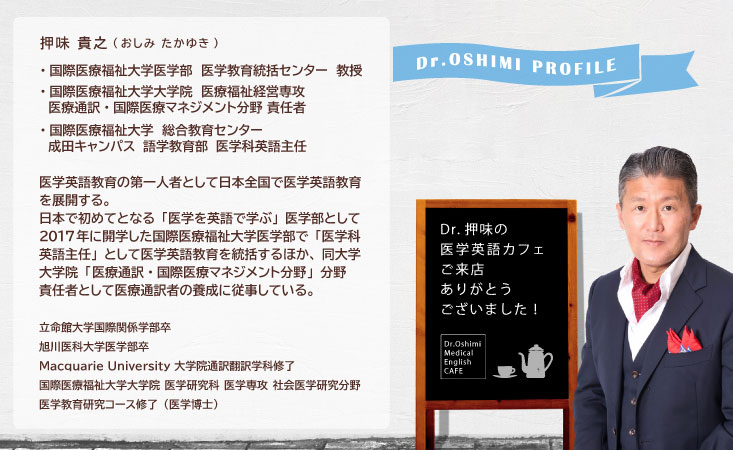
こんにちは。「医学英語カフェ」にようこそ。
ここは「コーヒー1杯分」の時間で、医学英語にまつわる話を気軽に楽しんで頂くコーナーです。
本日のテーマは「英語での症例プレゼンテーション:応用編」です。
海外での臨床実習において必要となる医学英語スキルは「医療面接」「カルテ記載」と「症例報告 = 症例プレゼンテーション」の3つです。
そしてこの3つの中で最も重要度が高く、また難易度も高いのが「症例プレゼンテーション」のスキルです。この「医学英語カフェ」でも3回に分けてこのスキルを紹介させて頂きました。
「Menu 30 英語での症例プレゼンテーション:基礎編」
「Menu 49 英語での症例プレゼンテーション:中級編」
「Menu 74 英語での症例プレゼンテーション:実践編」
これまでの3回のコラムでは、医学生が最初に身につけるべき Full Case Presentation のやり方をご紹介しましたが、実際の臨床現場ではそれぞれの目的に合わせて、SNAPPS, I-PASS, and SBAR といった様式の症例プレゼンテーションもあるのです。
そこで今月はこういった異なる様式に対応するために「英語での症例プレゼンテーション:応用編」をご紹介いたします。
Full Case Presentation とは?
まずはこれまでご紹介させて頂いたFull Case Presentation を確認しましょう。
これは医学生が最初に身につける症例プレゼンテーションの様式で、下記の12項目を含みます。
Full Case Presentation
- 1. Patient Information
- 2. History of Present Illness (HPI)
- 3. Past Medical History (PMHx)
- 4. Medications (DHx)
- 5. Allergies
- 6. Family History (FHx)
- 7. Social History (SHx)
- 8. Review of Systems (ROS)
- 9. Physical Examination (PE)
- 10. Summary
- 11. Differential Diagnosis (DDx)
- 12. Plan
医学生が6年次に経験する Post-CC OSCE においても、基本的にはこの様式で症例プレゼンテーションすることが求められますし、「症例報告」Case Report/Series として論文化する際にも、この様式で書くことが求められます。
そして「実践編」でもご紹介したように、この Full Case Presentation が求められている場面で、上記の項目順に行われないものはRandom-Walk Presentation として低評価となります。また上記の項目を網羅せず、医学生が都合のよい情報だけを拾って報告し、診断に必要な情報が十分に提供されないものも Cherry-Picking Presentation として低評価となります。また患者から聞いた情報を parrot「オウム」のように繰り返しているだけの症例プレゼンテーションで、診断に関する情報の意味づけがないものもParrot-Style Presentation と呼ばれ、やはり低評価の症例プレゼンテーションとなってしまいます。
これらの残念な Full Case Presentationに対して、理想的な診断志向型の症例プレゼンテーションのことを Diagnostic Framing Presentation と呼んでいます。まずは「実践編」でもご紹介しているように、下記の4つのステップを使って、Diagnostic Framing Presentation ができるようにしましょう。
4 Steps to Deliver an Effective Diagnostic Framing Presentation
- • Step 1. Patient Information: Use a one-liner with semantic qualifiers
- • Step 2. HPI: Highlight pertinent positives and negatives to guide the differential diagnosis
- • Step 3. PMH-ROS, and Physical Exam: Present systematically to avoid Cherry-Picking Presentation
- • Step 4. Summary: Combine a one-liner with key pertinent positives using semantic qualifiers
臨床推論のトレーニングに使われるSNAPPS
以上が Full Case Presentation に関するまとめですが、これ以外にも SNAPPS, I-PASS, and SBAR などの様式があります。
まずは SNAPPS から見ていきましょう。
1990年代の米国の医学教育では Learner-Centered Education が重視され始めました。しかし従来の症例プレゼンテーションの様式は、学生が話して指導医が答える一方通行の様式が多く、学生自身の臨床推論のスキルを深めにくいという課題がありました。
そこで考案されたのが SNAPPSです。1990年代に Case Western Reserve University の Wolpaw 教授らによって開発され、2003年に Academic Medicine 誌で発表されました。現在でも医学生が主体的に考え、臨床推論をトレーニングするための教育モデルとして使われています。
SNAPPS
- • Summarize the case
- • Narrow the differential
- • Analyze the differential
- • Probe the preceptor
- • Plan the management
- • Select a case-related topic
Summarize the Case「症例の要約」
History & Physical Exam の情報を簡潔にまとめて提示します。あまり長くせずに要点を押さえて提示するのが重要です。
This is a 55-year-old man with hypertension, poorly controlled diabetes, and long-term smoking, who developed recurrent substernal chest pain this morning while at rest during desk work. The pain was heavy, radiated to the left shoulder, arm, and molars, and was associated with cold sweats and anxiety. The initial episodes lasted a few minutes but became more frequent and progressed to prolonged pain of about 20 minutes. On exam, he is anxious and diaphoretic, with blood pressure of 150/90 mmHg and a regular pulse of 96 bpm. Cardiac exam is unremarkable, and there is no evidence of heart failure.
Narrow the Differential「鑑別疾患の絞り込み」
考えられる鑑別疾患の中から最も可能性の高いもの(3つ程度)に絞り込みます。
The most likely diagnosis is unstable angina. Differential diagnoses include myocardial infarction and pulmonary embolism.
Analyze the Differential「鑑別診断の分析」
候補に挙げた鑑別疾患について、なぜその疾患を考えるのか、またなぜ他の鑑別疾患の可能性が低いのかを説明します。臨床推論の根拠を言語化するトレーニングになります。
Unstable angina fits best because of the rest onset, crescendo pattern, radiation, and associated autonomic symptoms. Myocardial infarction is less likely because the pain episodes, though prolonged compared to stable angina, have not exceeded 30 minutes and there is no evidence yet of myocardial necrosis. Pulmonary embolism is less likely given the absence of dyspnea, hypoxemia, pleuritic chest pain, or risk factors such as recent surgery or immobilization.
Probe the Preceptor「指導医への質問」
今回の症例に関連して、自分が疑問に思う点を指導医に尋ねます。
I am unsure whether morphine should be given in this patient. Since he is hemodynamically stable and may respond to nitrates, I wonder if morphine is appropriate or should be reserved only if pain persists despite standard therapy.
Plan the Management「治療計画」
検査や治療に関して「自分ならどうするか」を考えて提示します。
I would perform ECG, troponin testing, and echocardiography. I would give aspirin and heparin and arrange early coronary angiography with possible PCI. I would also monitor closely for recurrent pain or instability.
Select a Case-Related Topic「自主学習内容の選択」
症例に関連して、自主学習すべき内容を自分で選択します。
For self-directed learning, I will review current guidelines on the use of morphine in unstable angina and NSTEMI.
以上がSNAPPS の内容です。「臨床推論を重点的にトレーニングしたい」という場合には最適の様式ですので、是非使ってみてください。
引き継ぎ目的で使われる I-PASS
I-PASSとは勤務交代時の handoff「患者引き継ぎ」を安全に行うために開発された様式です。2000年前後、米国では医療事故の多くがコミュニケーションエラーによるものであることが注目され、特に handoff の不備が問題視されました。特に2003年に研修医の勤務時間制限が導入されてからは交代勤務が増え、handoff の標準化が急務となりました。
この流れの中で Boston Children’s Hospital を中心に開発された I-PASS は、2012年の研究で有効性が示され、さらに 2014年の landmark study では、医療過誤を約23%、予防可能な有害事象を約30%減少させることが明らかになりました。現在では米国のみならず、欧州やアジアの病院でも広く導入され、小児科・内科・外科の研修医教育に組み込まれています。
I-PASS
- • Illness Severity
- • Patient Summary
- • Action List
- • Situation Awareness & Contingency Plan
- • Synthesis by Receiver
Illness Severity「重症度」
患者の鑑別疾患と重症度 (stable, watcher, or unstable) を最初に提示します。
This is a 55-year-old man with suspected unstable angina. Differential diagnoses also include myocardial infarction and pulmonary embolism. Given the clinical course, the illness severity is classified as unstable.
Patient Summary「患者情報の要約」
History & Physical Exam の情報を簡潔にまとめて提示します。あまり長くせずに要点を押さえて提示するのが重要です。
This is a 55-year-old man with hypertension on amlodipine, poorly controlled diabetes on metformin, and long-term smoking, who developed recurrent substernal chest pain this morning while at rest during desk work. The pain was heavy, radiated to the left shoulder, arm, and molars, and was associated with cold sweats and anxiety. The initial episodes lasted a few minutes but became more frequent and progressed to prolonged pain of about 20 minutes. On exam, he is anxious and diaphoretic, with blood pressure of 150/90 mmHg and a regular pulse of 96 bpm. Cardiac exam is unremarkable, and there is no evidence of heart failure.
Action List「行動計画」
今後の検査・治療の計画を明確に伝えます。
We will do an ECG, check troponin, and perform an echocardiogram. We plan to give aspirin and heparin and arrange early coronary angiography with possible PCI.
Situation Awareness & Contingency Plan「状況の認識と不測の事態への対応計画」
今どのような状態にあるかを述べた後、今後予測される事態への対応策も述べます。
The most likely diagnosis is unstable angina. Other possibilities include myocardial infarction and pulmonary embolism. If the chest pain continues, vital signs worsen, or the ECG shows new changes, we will call the cardiology team right away for urgent care.
Synthesis by Receiver「受け手側による確認」
最後に情報の受け手に確認してもらうことで、情報伝達ミスを防ぎます。
Please confirm this summary and let me know if you have additional recommendations.
以上がI-PASS の内容です。海外臨床実習先で使われる場面があるかもしれませんので、しっかりと対応できるようにしておきましょう。
緊急時に使われる SBAR
最後にご紹介するのが SBAR です。これは元々米国海軍の潜水艦や原子力空母などの軍事現場で使われていた報告様式で、重大な情報を短時間で伝達する必要性から生まれました。その後医療現場にも導入され、現在では医師の間だけでなく、広く医療者間での緊急時の伝達様式として国際的に用いられています。
SBAR
- • Situation
- • Background
- • Assessment
- • Recommendation
Situation「状況」
患者の基本情報と主訴に関する情報を簡潔に述べます。
This is a 55-year-old man with recurrent chest pain at rest, radiating to the left shoulder and accompanied by cold sweats.
Background「背景」
既往歴やリスク因子などの関連情報をごく簡単に加えます。
He has a history of hypertension on amlodipine and poorly controlled diabetes on metformin. He smokes one pack per day for 30 years, drinks socially, and works in a high-stress managerial position.
Assessment「評価」
考えられる鑑別疾患を簡潔に述べます。
The most likely diagnosis is unstable angina. Differentials include myocardial infarction and pulmonary embolism.
Recommendation「次の行動」
次に何をすべきかを簡潔に述べます。
I recommend immediate ECG, troponin testing, and echocardiography. Start aspirin and heparin and prepare for early coronary angiography with possible PCI.
以上がSBAR の内容です。他の様式と比べて極めて簡潔である点が特徴です。
このように症例プレゼンテーションには目的に応じた多様なスタイルがあります。
以上をまとめると「初心者の教育には Full Case Presentation」「臨床推論のトレーニングには SNAPPS」「引き継ぎには I-PASS」「緊急時には SBAR」という様式が使われます。
さてそろそろカップのコーヒーも残りわずかです。最後にもう一度今回紹介した SNAPPS, I-PASS, and SBAR のそれぞれの項目をお示しします。
SNAPPS(臨床推論トレーニング用)
- • Summarize the case
- • Narrow the differential
- • Analyze the differential
- • Probe the preceptor
- • Plan the management
- • Select a case-related topic
I-PASS(誤解を生まない引き継ぎ用)
- • Illness Severity
- • Patient Summary
- • Action List
- • Situation Awareness & Contingency Plan
- • Synthesis by Receiver
SBAR(時間のない緊急時用)
- • Situation
- • Background
- • Assessment
- • Recommendation
ではまたのご来店をお待ちしております。
「Dr. 押味の医学英語カフェ」では、読者の皆さまがこの連載で取り上げてほしい医学英語のトピックを募集しています。こちらのリンクよりご希望のトピックを自由に記載してお送りください。
国際医療福祉大学医学部 医学教育統括センター 教授
押味 貴之










